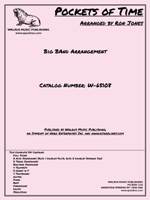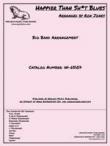POCKETS OF TIME
Arranged by Ron Jones

Cat #: W-65108
$50.00This item usually ships within 1 business day.
Questions?
Please call +1-518-587-1102 or email us.
Edition: Jazz Big Band Arrangement
Description: Swing - Advanced
Publisher: Walrus Music Publishing
From Composer Ron Jones:
"Level: Advanced
Highest lead trumpet note a written D# above high C.
Written for my L.A. big band, The Infl uence Jazz Orchestra, this chart features solos for Tenor Sax and Flugel Horn
as well as a lot of exposed soli sections for Bass Clarinet and Bass. The Guitar as well as the Vibes have a key
role in sharing the lead and melodic duties with other sections. The Rhythm section is really voiced and orchestrated
with a lot of fully written out parts. The Infl uence Jazz Orchestra has not only the normal Big Band instrumentation
but also a full French Horn section, Vibes and Percussion. The chart is playable with or without these parts but
a richer orchestrational canvas comes to life with the full instrumentation of course. Our French Horn players love
being part of the Jazz Band and they bring a lot to the sound created. The added Vibes and Percussion also brings
color and drive to the overall e ect and gives the audience a dazzling array of interesting things to both see and
hear.
The tempo is a medium, straight-ahead 116 BPM, relaxed swing feel. The intro begins with the Left-hand piano,
Bass and Bass Clarinet playing a melodic lick as the mixed orchestration of Muted trumpets and Trombones along
with the Sax/Woodwind section, Horns, Guitar and Vibes lay down a response of color/texture pads on the top.
At bar 22 the Sax/WW’s, guitar and vibes lay down the melody. In bars 30-35 an interesting, fully voiced section of
Guitar, Piano and Vibes take over as the Drums and perc keep time going. The Sax/WW section comes in at 36 over
muted trumpets with horns. The Bass Clarinet and Bass take the melodic lick at 38 with the added Bass Trombone
and Left-Hand Piano. The chart stays at the same tempo at Bar 42 but shifts to a half-Time feel with Flute, Sop. Sax,
Guitar and Vibes covering the melody while Horns, Trumpets and Bones take the backing gures. Bar 50 has the
Tenors, Trumpets, Guitar and Vibes in octaves as the Bones and remaining Sax/WW’s handle the supporting chords.
As things move along the melody shifts to the Sax/WW’s, Guitar and Vibes as everything builds dynamically.
Bar 60 starts a section where the Trumpets, Bones and Guitar carry the melodic aspects as Sax/WW’s play rhythmic
chord gures. At bar 64 that ips. Bar 68 has the Rhythm Section on fully voiced chord pads with the Bass Clarinet
and Bass playing it’s melodic idea from earlier in the piece. Mixed Colors of WW’s and Muted Trumpets do ll
gures in between the bass line statements. At Bar 76 Lead Tenor has changes to solo over with the Rhythm Section
in support. Various gured played by the Sax/WW’s,Vibes and Brass punctuate the background as the Tenor solos
develops bars 94-105.106 has the Bass Clarinet/Bass trading two-bar gures as Color/texture pads play on top.
Bar 118 is where Flugel Horn (or Trumpet) II plays its solo. 130 starts a quiet (mp) section with two-bar phrases
bouncing back and forth between mixed orchestrational groupings. This section is followed by a return to the fully
voiced titti rhythm section restated from earlier in the piece. This all leads to a sort of extended “Shout-” section
for the full band playing at a forte dynamic. The Sax section takes over at 154 and the Brass joins in with them at
bar 158.
Things heat up and continue building until at 164 the Trumpets, Bones, Guitar and Vibes State the Melody in
octaves and the Saxes and Horns back things up. 172 returns us to the Bass Clarinet/Bass playing their melodic
lick as in the beginning in two-bar interplay with the Sax/WW’s and Brass. The Rhythm Section has full color
chords as everything winds quietly down to a soft held chord ending as the lead Tenor solos.
This piece is about color, mood and development of the melodic gures as they are tossed around from section to
section. The Bass Clarinet, Bass along with the Guitar abd Vibes get to be more out front as they carry much of the
important melodic gures. A great, challenging but fun chart if you have a pocket of time to work on it. Every
secition and player is featured in one way or another."
2 Alto Saxophones (Alto 1 Doubles Flute, Alto 2 Doubles Soprano Sax)
2 Tenor Saxophones
Baritone Saxophone
4 Trumpets
2 Horns in F
4 Trombones
Guitar
Piano
Bass
Vibraphone
Drums
Percussion







![POCKETS OF TIME [DOWNLOAD] View: POCKETS OF TIME [DOWNLOAD]](https://www.ejazzlines.com/wp-images/product/thumbnail/w65108.jpg)

